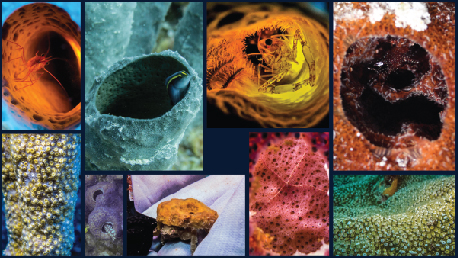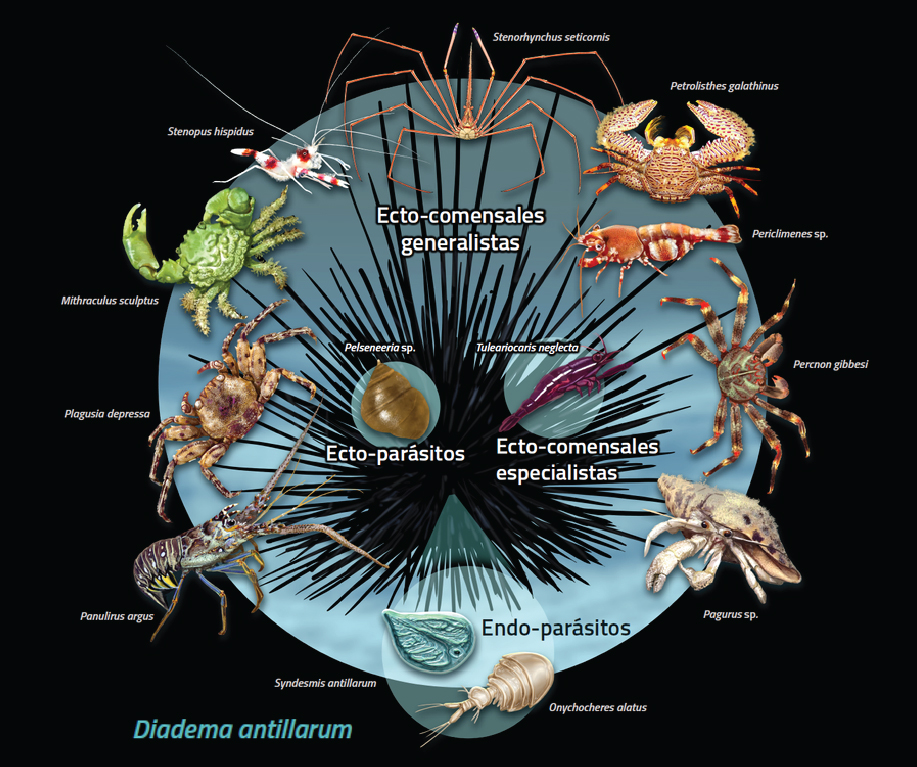
!Bienvenido!
Marine species interactions es un proyecto que surge de la necesidad de entender y estudiar los diferentes procesos y patrones que están detrás del establecimiento de distintas relaciones simbióticas en ambientes costeros y marinos. Estamos interesados en temas sobre ecología de interacciones, redes ecológicas y biogeografía de interacciones.
Las principales preguntas que buscamos responder son, ¿Qué tipo de interacciones estamos observando?, ¿Qué especies tienen una relación generalista o especialista?, ¿Cuál es la importancia de ciertos grupos de organismos dentro de la red de interacciones? o ¿Qué implicaciones tiene la diversidad de interacciones con la biodiversidad de un lugar?
Hasta el momento nuestros estudios se centran en el Atlántico Americano, pero estamos dispuestos a ampliar nuestros horizontes.
¿Quieres participar?
De interés
Frontiers in Marine Science
The importance of home cleaning: Burrow and sediment transport by alpheid shrimps provides a competitive advantage to their host anemones
Pérez-Botello, AM et al. (2021)
Biodiversity Data Journal
Sponge dwelling-fauna: a review of known species from the Northwest Atlantic coral reefs.
Pérez-Botello, AM. & Simões N (2021)
Juego de datos interactivo
Sponge dwelling-fauna from the Northwestern Atlantic Ocean: a bibliographic records database.
Pérez-Botello, AM. & Simões N
Publicaciones recientes
Juego de datos
Sponge dwelling-fauna from the Northwestern Atlantic Ocean: a bibliographic records database.
Pérez-Botello, AM. & Simões N
Juego de datos
Paguroidea-Mollusca-Interactions V1.0
Cervantes, G
Juego de datos
Echino-Interactions V3.0
Soleto-Casas, RC & Simões, N
Global Coral Reef Week
Callyspongia aculeata dwelling-fauna in Cayo Arcas reef
Pérez-Botello, AM. & Simões N (2020)
5th WCMB
Guest-host interactions as diversity drivers in coral reefs
Pérez-Botello, AM et al (2020)
Nuestros proyectos
Fauna asociada a esponjas
Sponge dwelling-fauna
Proyecto enfocado en la caracterización y descripción de la fauna huésped de esponjas marinas. Nuestros objetivos son: (1) documentar los organismos involucrados, (2) clasificar el tipo de interacciones presentes y (3) analizar la importancia de cada especie en la red de interacciones.
Responsables: Antar Mijail Pérez Botello y Nuno Simões
Contacto: antarmijail@comunidad.unam.mx
Estado: Activo

Fauna asociada a equindermos
Echinoderm symbionts
Proyecto orientado a describir los procesos ecológicos que hay detrás de la relacion equinodermo-simbionte. Nuestros objetos son: (1) Integrar una base de datos actualizada y estandarizada sobre reportes de fauna asociada a equinodermos (2) identificar vacíos de información y (3) analizar los patrones de distribución y recurrencia de dichas asociaciones
Responsables: Rosa Carmen Sotelo Casas y Nuno Simões
Contacto: rosacarmensotelocasas@gmail.com
Estado: Activo

Fauna asociada a cnidarios sésiles
Sessile cnidarians associated fauna
Proyecto orientado a analizar el tipo de interacciones presentes en cnidarios sésiles como anémonas y corales
Responsables: Ricardo González, Antar Mijail Pérez Botello y Nuno Simões
Contacto: ns@ciencias.unam.mx
Estado: Próximamente

Abstract
Guest-host interactions as diversity drivers in coral reefs
Pérez-Botello, AM; Sotelo-Casas, RC ; González-Muñoz R, Dáttilo W; Simões N
Despite being often ignored, the diversity of ecological interactions is one of the main facets of biodiversity. At coral reefs, the guest-host interactions have been recognized as an important speciation mechanism and structuring of the biodiversity present in this underwater ecosystem. The present work analyses the organization of the interaction networks involving three major host groups: cnidaria, echinoderms, and sponges, present at the American Tropical coral reefs. These host organisms share a particular characteristic, they all provide shelter and food sources to a wide range of sessile and mobile animals. Specifically, we describe the organization of the interaction network and the roles of some individual species, measuring the Nestedness (i.e., the extent to which the interaction partners of one species present a subset of the interaction partners of another species), the Modularity (i.e., the propensity of different subsets of species in the network to interact more frequently with each other than with the rest of the species in the network) and the centrality (i.e., structural importance of a species in the network). With this approach, we model the importance of guest-host interactions in maintaining biodiversity and define which species could be keystones in the American Atlantic coral reefs.
Abstract
Callyspongia vaginalis dwelling-fauna in Cayo Arcas coral reef.
Pérez-Botello, AM; Simões Nuno
The tubular sponge Callyspongia vaginalis is a solitary and dominant organism in the Gulf of Mexico and the Caribbean Sea coral reefs. Previous studies suggest the sponge’s aggregations will form animal forests, shaping habitats, and providing three-dimensionality to the reefs. The main objective of this work was to describe the relationship between the guest's symbiont diversity with sponge complexity. Using a photogrammetry process, the sampled sponges were digitized. The complexity was measured with an index that summarizes the digital sponge morphological characteristics. The host species changes were analyzed in two scales: local and individual. All the dwelling fauna was identified at the lowest taxonomic level. The correlation between complexity and species richness is positive, an increase in complexity means an increase in species number. In conclusion, the potential to host species was directly related to the sponge heterogeneity. This process could be mediated by colonization-dispersion cycles and refuge competition.
Citation: Pérez-Botello, AM. & Simões N (2020). Callyspongia aculeata dwelling-fauna in Cayo Arcas reef. Global Coral Reef Week. Remote Meetings to Connect Coral Reef Scientists Around the World















